Colville Confederated Tribes
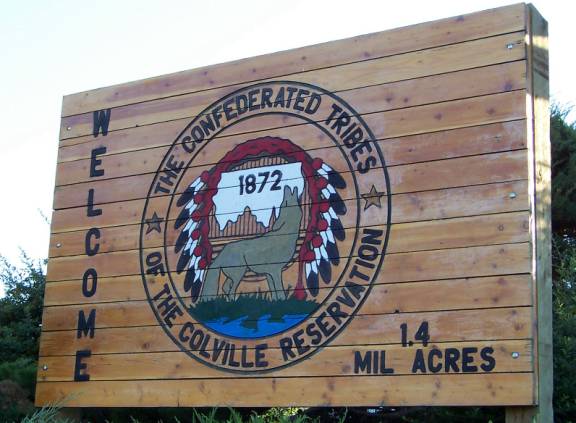 Background
Background- Transportation System
- Planning and Proposed Projects
- Projects Underway
- Other Projects and Roadways
- Best Practices Identified
- Issue and Needs
Background
The Colville Indian Reservation is located in North-Easterly Washington State and covers an area of 1.4 million acres. There are approximately 965 miles of road maintained by the BIA roads branch and approximately 700 miles of state and county roads on the reservation.
The Colville reservation is in 2 Washington State DOT (WSDOT) regions and 2 Regional Transportation Planning Organizations (RTPO). The tribe has a comprehensive transportation plan that was completed in 1989 and has been updated once since that time.
Parts of Okanogan and Ferry counties are within the boundaries of the reservation. There are approximately 5000 tribal and 5000 non-tribal members that reside on the reservation.
Transportation System
There are approximately 965 miles of roads on the Colville reservation that are maintained by the BIA. This includes 120 miles of paved road, about 100 miles of gravel roads, and 745 miles of earth roads.
State highway 21 traverses the reservation from the state run Keller Ferry in the south to the reservation boundary approximately 40 miles north. State Highway 155 travels from the Grand Coulee Dam north to Colville Indian Agency and Nespelem, then northwest to Omak. There are approximately 54 miles of SH 155 on the reservation.
The Colville tribes also operate a ferry between Inchelium and Gifford in the eastern part of the reservation. The ferry connects the reservation road at Inchelium to State Highway 25, a north-south route.
Average annual funding for the tribe is $2 million for construction, $100,000 for Preliminary Engineering, $35,000-40,000 for transportation planning. The tribe also receives approximately $1,157,000 for maintenance. Included in the maintenance funds is $530,000 for the ferry at Inchelium.
County roads make up an additional 576 miles of roadway on the reservation. Roads constructed by the BIA had been transferred to the counties several years ago. The tribe has taken some of the road miles back and is working with the counties to take back other routes. The tribe and counties have cooperative agreements with the counties on snow plowing and road maintenance.
Counties are affected by the amount of federal lands in the area. There is a limited tax base because of the BLM, Forest Service, and reservation. The counties are dependent upon the Colville tribe for transportation.
Some residents of the reservation have commutes of 100 miles or more per day. There is also a need for transit, especially for residents of low-income HUD sites.
Planning and Proposed Projects
The Colville tribe develops projects for the IRR TIP and also attends RTPO meetings.
The tribe has a number of projects in their five-year priority plan. The projects include IRR funded projects, IRR Bridge funded projects, and Transportation Enhancement projects.
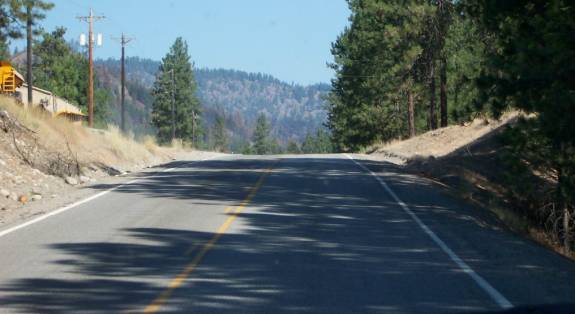
Proposed Keller Bicycle Path Site
Keller Bicycle Path
The tribe has received approval from WSDOT to use the State right-of-way easement on both shoulders of State Highway 21 to construct a bicycle path. $31,000 from WSDOT will fund the design and right-of-way costs for the project.
Nespelem Bicycle Path
This project has been in the planning stages for about six years. $400,000 from the WSDOT Regional Office will fund the design, ROW, and construction of this project.
Inchelium Bridge
The tribe has proposed a project to replace the existing ferry with a bridge across Lake Roosevelt (Columbia River). The tribe is recommending that $120,000 be made available for a feasibility study for the estimated $44 million construction project.
Safety Project at East Omak Elementary School
Project has been submitted to state for funding as a safety project, but has been unsuccessful. The proposed project is to install concrete barriers to separate the roadway from pedestrians at the underpass.
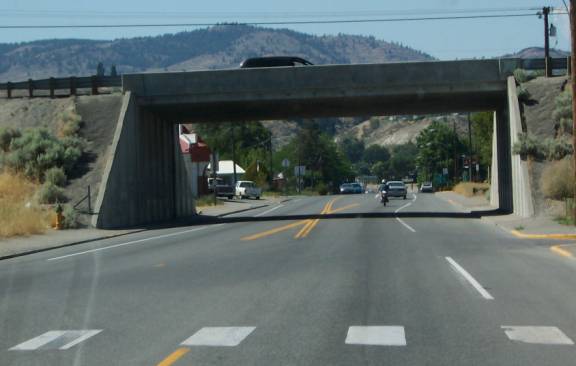
Proposed Safety Project Site
Projects Underway
Oak Street Bridge Project
The Oak Street Bridge is in Okanogan, WA. The tribe has recommended providing up to $1.5 million in IRRBP funds for this project that is being administered by WSDOT. IRRBP funds can construct eligible non-BIA IRR bridges for an amount not to exceed $1.5 million per bridge.
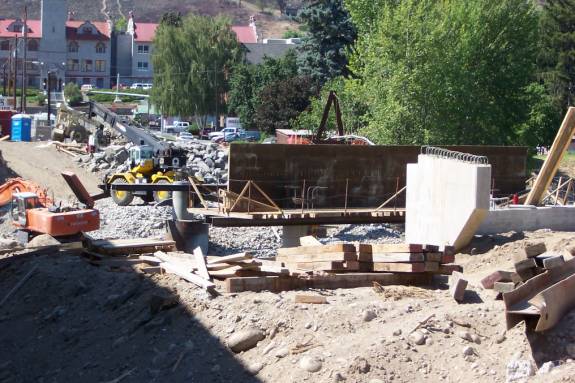
Oak Street Bridge Construction
Omak Lake Road
The Omak Lake Road is an 11 mile project that is underway on the western part of the Colville Reservation. The $3.7 million project will involve surveying, base course, guardrail installation, paving, sign installation, and pavement markings.
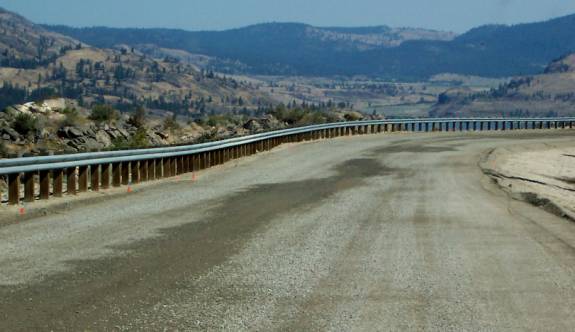
Omak Lake Road
The tribe had a Heavy Construction Training Program on the Omak Lake Road project that trained about 40 people. The training program constructed 8.3 miles of roadway.
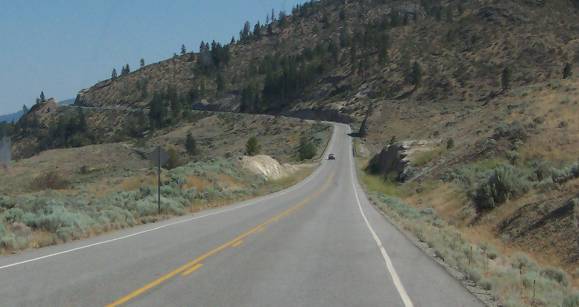
Omak Lake Road Completed Section
Other Projects and Roadways
Cache Creek Road
The tribe took over jurisdiction of the Cache Creek Road from the county in 1997. The tribe has completed 4 phases of projects on Cache Creek Road between 1995 and 2002. The road includes shoulders and passing lanes, guardrail, and post mounted delineation. The Cache Creek Road carries logging traffic throughout the year.
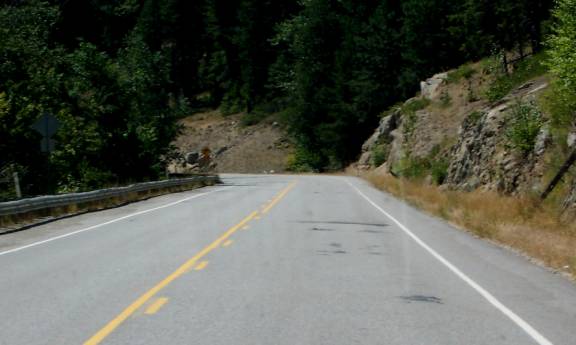
Cache Creek Road
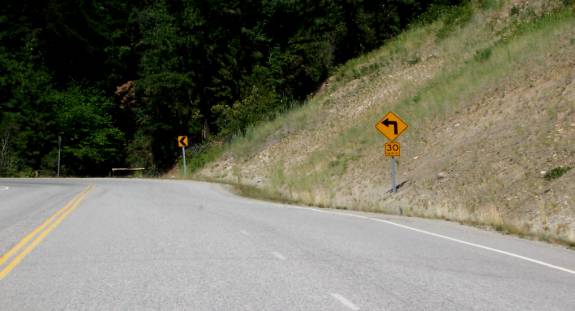
Cache Creek Road Passing Lane Section
Silver Creek Road
The Silver Creek Road was built by the BIA in the 1950's and 1960's. The road was maintained by the county over the years and is now a BIA road. The road begins at the San Poil River off of State Highway 21 and goes east up a steep grade to an elevation of approximately 3000 feet.
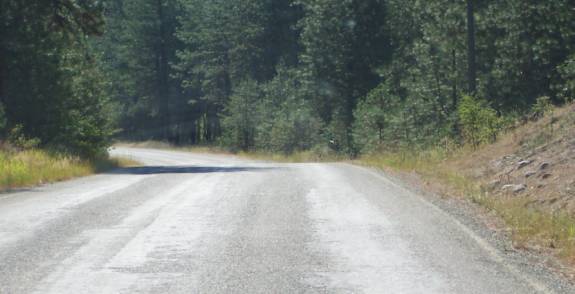
Silver Creek Road
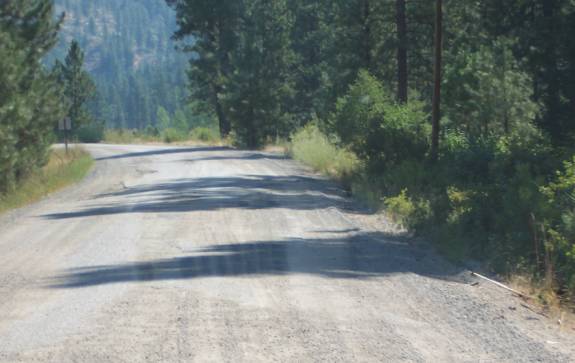
Silver Creek Road
The road was bituminous surface treaded (BST) at one time and has now deteriorated to gravel with some patches of BST remaining. The tribe has a ten-mile project for resurfacing and guardrail scheduled for 2005.
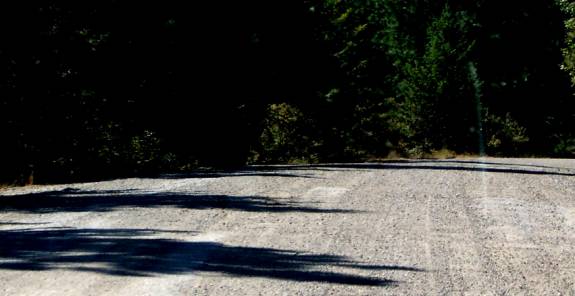
Silver Creek Road
Bridge Creek Road
Bridge Creek Road is a count road that runs east-west from Inchelium, past Twin Lakes, to SH 21. There are housing areas at the Twin Lakes area that are served by the Bridge Creek Road. There is a High School and a new Community Health Clinic on the road at Inchelium. The Health Clinic serves tribal and non-tribal members in the community.
A section of the road paved in 2001 has significant rutting in the surface. There is a section that the tribe has identified as high crash location.
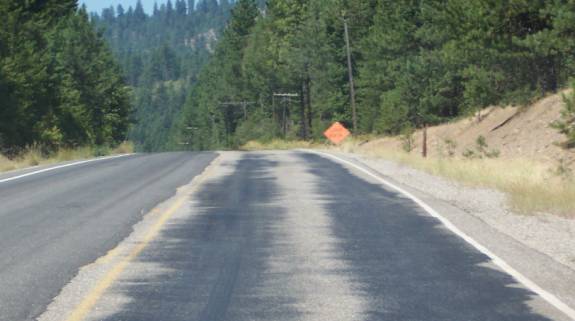
Rutting on Bridge Creek Road
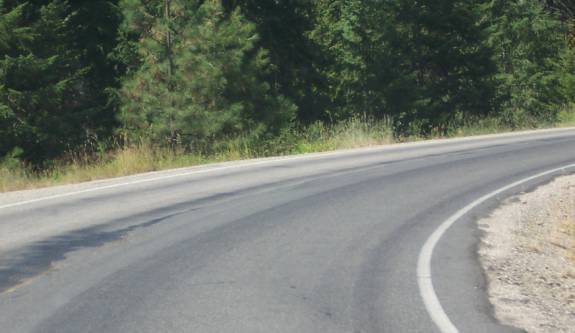
Location of Crashes on Bridge Creek Road
Manila Creek Road
Manila Creek Road is a county road between SH 155 and SH 21.
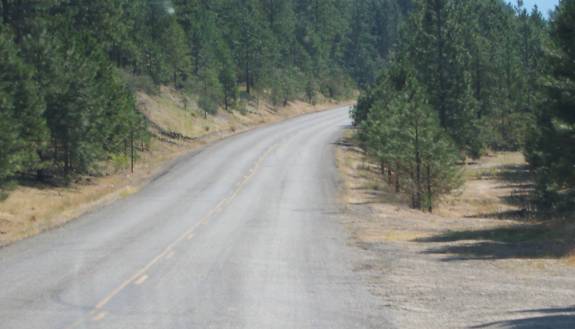
Inchelium Road
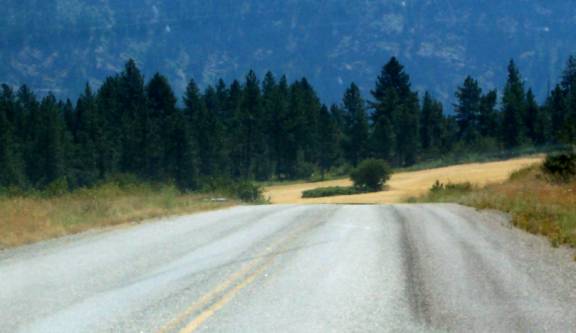
Inchelium Road Approaching Ferry
State Highway 21
State Highway 21 is a north-south route through the reservation. SH 21 passes through Keller on the reservation.
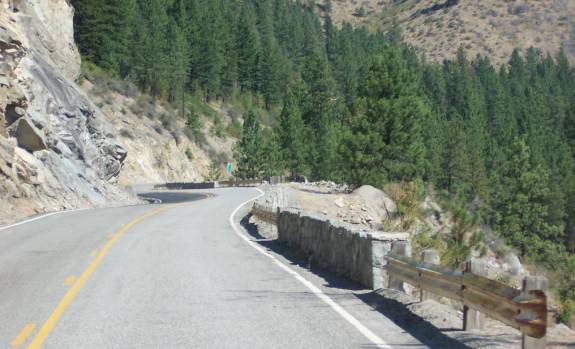
School Crossing at Nespelem School
A project consisting of an overhead school crossing sign and flashing lights was completed by the state at SH 155 at the Nespelem school.
Ferry
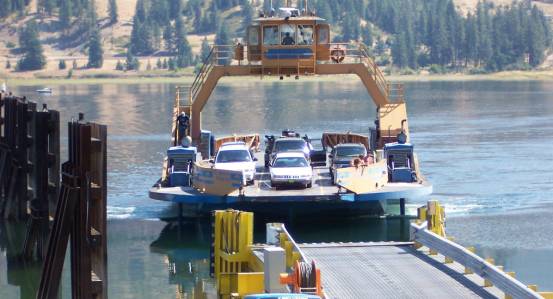
Ferry at Inchelium
The Colville Tribe operates a free ferry, the Columbia Princess, between Inchelium and Gifford on of Roosevelt Lake (Columbia River) on the eastern side of the reservation. The ferry operates between 7 days per week between 6:30 AM and 10:00 PM. The tribe operates the ferry under a Public Law 93-638 contract. The average daily traffic for cars is 227. One round trip takes approximately 30 minutes.
The ferry began operation in 1982. The ferry cost $28 million when purchased by the tribe. The tribe recently received $940,000 in Ferry Boat Discretionary funds to construct the new dock facility. IRR funding was also included in the $1.6 million project that was completed in 2002.
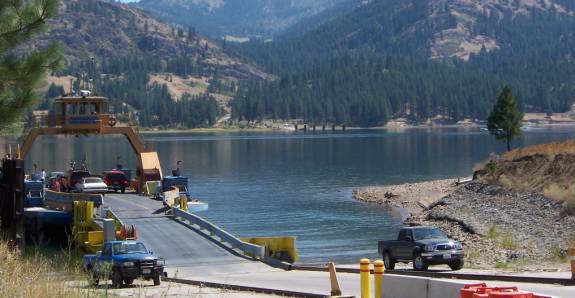
Ferry at Inchelium
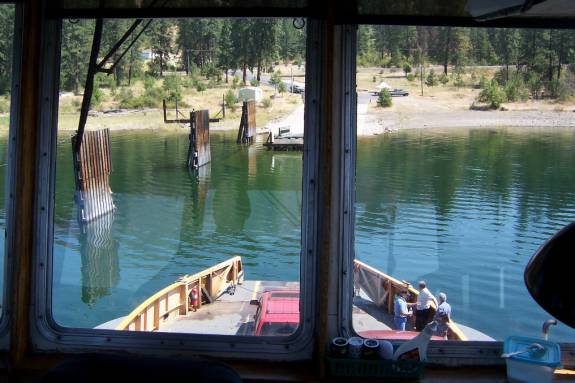
Approaching Gifford
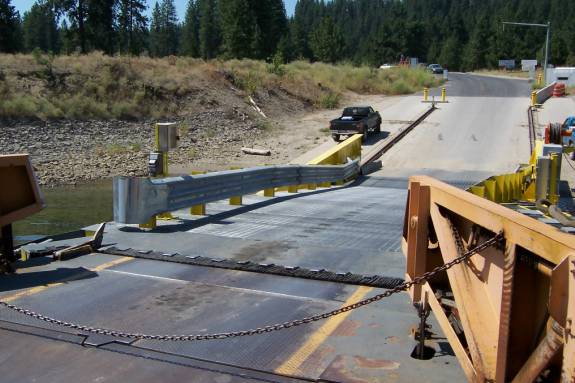
Docking at Inchelium
Best Practices Identified
The Colville reservation is in two 2 WSDOT Regions. Each region has a designated tribal liaison that has worked with the tribe on transportation issues.
The Colville tribal government planner regularly participates in RTPO meetings.
Issue and Needs
The Colville tribe has a need to better utilize safety data. There is currently not good information on what traffic records and safety data exists.
The Colville Tribe would like to have projects that a funded directly from FHWA and USDOT modes.
To provide Feedback, Suggestions or Comments for this page contact Tim Penney at tim.penney@dot.gov.